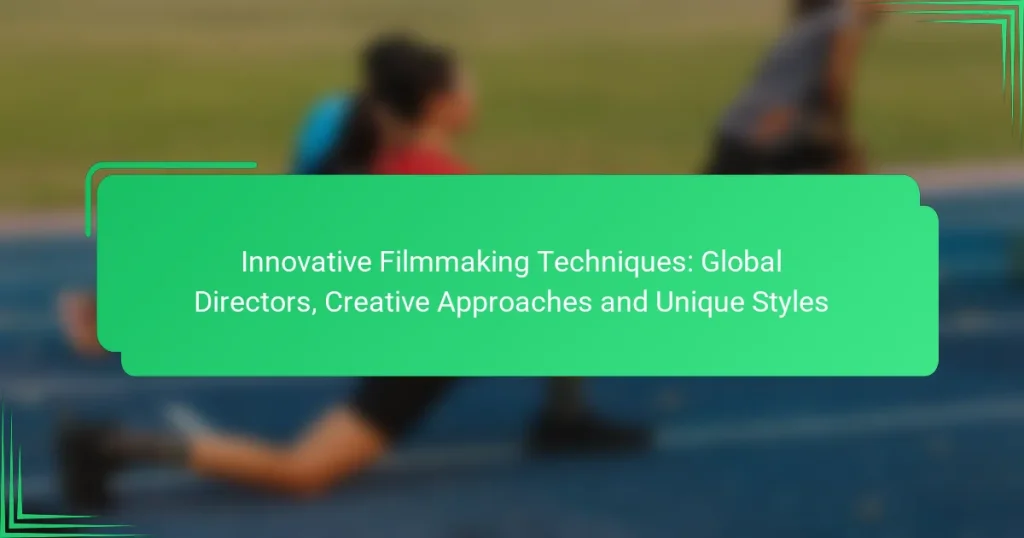Innovative filmmaking techniques are transforming the landscape of cinema, as global directors explore new methods to enhance storytelling and engage audiences. From virtual reality and drone cinematography to interactive narratives, these creative approaches allow filmmakers to express their unique visions and immerse viewers in unforgettable experiences. By blending distinctive styles with experimental techniques, modern filmmakers are redefining the art of storytelling in compelling ways.

What Innovative Filmmaking Techniques Are Being Used by Global Directors?
Global directors are increasingly adopting innovative filmmaking techniques that enhance storytelling and viewer engagement. These methods include virtual reality, interactive storytelling, drone cinematography, augmented reality integration, and non-linear narrative structures, each offering unique ways to immerse audiences in cinematic experiences.
Virtual Reality in Filmmaking
Virtual reality (VR) allows filmmakers to create immersive environments where viewers can experience the story from a first-person perspective. This technique requires specialized equipment and software, often leading to higher production costs but offering a unique engagement level that traditional films cannot match.
Directors like Alejandro González Iñárritu have experimented with VR to enhance emotional connections. When considering VR, it’s essential to focus on user experience, ensuring that the narrative remains compelling and that the technology does not overshadow the story.
Interactive Storytelling
Interactive storytelling empowers viewers to make choices that influence the narrative’s direction. This approach can lead to multiple endings and varied experiences, making each viewing unique. Platforms like Netflix have explored this with titles such as “Black Mirror: Bandersnatch.”
When implementing interactive elements, filmmakers should balance interactivity with narrative coherence. Overly complex choices can confuse viewers, so clear pathways and logical story arcs are crucial for maintaining engagement.
Drone Cinematography
Drone cinematography has revolutionized aerial shots, allowing filmmakers to capture stunning visuals from perspectives that were previously difficult or expensive to achieve. Drones can provide sweeping landscapes or intricate details at a fraction of the cost of traditional helicopter shots.
While using drones, filmmakers must comply with local regulations regarding airspace and safety. In many countries, operators need licenses, and certain areas may have restrictions, so it’s vital to research these regulations before filming.
Augmented Reality Integration
Augmented reality (AR) blends digital elements with the real world, enhancing the viewer’s experience by overlaying graphics or information onto live-action footage. This technique can be particularly effective in marketing campaigns or interactive installations.
Directors should consider the audience’s familiarity with AR technology. Ensuring that the integration enhances rather than distracts from the narrative is key to successful implementation.
Non-linear Narrative Structures
Non-linear narrative structures break away from traditional storytelling by presenting events out of chronological order. This technique can create suspense and deepen character development, as seen in films like “Pulp Fiction” and “Memento.”
When using non-linear storytelling, clarity is essential. Filmmakers should provide enough context for viewers to follow the plot while maintaining the intrigue that comes from a non-linear approach. Careful editing and pacing are crucial to avoid confusion.

How Do Creative Approaches Enhance Filmmaking?
Creative approaches enhance filmmaking by allowing directors to express unique visions and engage audiences on deeper emotional levels. Techniques such as character-driven storytelling, visual metaphors, and experimental sound design contribute to a richer cinematic experience.
Character-Driven Storytelling
Character-driven storytelling focuses on the development of characters rather than the plot itself. This approach allows filmmakers to create relatable and complex characters that resonate with audiences, making the narrative more impactful. For instance, films like “The Pursuit of Happyness” showcase personal struggles, drawing viewers into the emotional journey.
To effectively implement character-driven storytelling, filmmakers should invest time in character backstories and motivations. This can involve workshops or collaborative writing sessions with actors to ensure authenticity. Avoid clichés and strive for depth to keep audiences engaged.
Visual Metaphors and Symbolism
Visual metaphors and symbolism enrich storytelling by conveying complex ideas through imagery. This technique allows filmmakers to communicate themes and emotions without explicit dialogue. For example, in “The Shape of Water,” the water serves as a metaphor for connection and isolation.
When using visual metaphors, consider how symbols can enhance the narrative. Aim for subtlety; overt symbols can feel forced. A well-placed object or color can evoke strong emotions, so think carefully about visual choices that align with the story’s themes.
Experimental Sound Design
Experimental sound design breaks traditional audio norms to create immersive experiences. This technique can manipulate soundscapes to evoke specific feelings or enhance storytelling. Films like “A Quiet Place” utilize silence and sound in innovative ways to heighten tension and engagement.
To experiment with sound design, consider layering sounds or using unconventional audio sources. Collaborate with sound designers to explore unique auditory elements that complement visual storytelling. Be cautious, however, as overly complex soundscapes can distract rather than enhance the narrative.

What Unique Styles Define Modern Filmmakers?
Modern filmmakers are characterized by distinctive styles that reflect their creative visions and storytelling techniques. These unique approaches often blend visual aesthetics, narrative structures, and thematic elements to create memorable cinematic experiences.
Wes Anderson’s Symmetry and Color Palette
Wes Anderson is renowned for his meticulous use of symmetry and vibrant color palettes, which create a whimsical and visually striking atmosphere in his films. His compositions often feature centered shots and balanced framing, drawing the viewer’s eye to the intricate details within each scene.
To emulate Anderson’s style, filmmakers should focus on selecting a cohesive color scheme that enhances the narrative. Using pastel colors or bold primary hues can evoke specific emotions, while maintaining symmetry in framing can add a layer of visual harmony. For example, films like “The Grand Budapest Hotel” showcase this technique effectively.
Christopher Nolan’s Non-linear Storytelling
Christopher Nolan is famous for his non-linear storytelling, which challenges traditional narrative structures by presenting events out of chronological order. This technique engages audiences by requiring them to piece together the story, often leading to deeper emotional connections and heightened suspense.
Filmmakers interested in this approach should consider how to manipulate time and perspective within their narratives. Techniques such as flashbacks, parallel storylines, and time loops can create complexity. “Inception” and “Memento” are prime examples of how non-linear storytelling can captivate viewers and provoke thought.
Guillermo del Toro’s Fantasy Aesthetics
Guillermo del Toro’s films are celebrated for their rich fantasy aesthetics, blending horror elements with fairy tale motifs. His unique visual style often incorporates elaborate creature designs and lush, imaginative worlds that evoke a sense of wonder and dread simultaneously.
To adopt del Toro’s aesthetic, filmmakers should invest in detailed world-building and character design. Utilizing practical effects alongside CGI can enhance the realism of fantastical elements. Films like “Pan’s Labyrinth” exemplify how combining dark themes with enchanting visuals can create a powerful narrative impact.

Which Filmmaking Techniques Are Most Effective for Audience Engagement?
Effective filmmaking techniques for audience engagement include immersive storytelling, relatable character development, and interactive elements that invite viewer participation. These approaches create a deeper connection between the audience and the film, enhancing emotional investment and overall experience.
Immersive World-Building
Immersive world-building involves creating detailed and believable settings that draw viewers into the film’s universe. Techniques such as extensive set design, authentic locations, and rich visual effects can transport audiences, making them feel as if they are part of the story. For example, films like “Avatar” and “The Lord of the Rings” utilize extensive world-building to captivate viewers.
To achieve effective world-building, filmmakers should focus on consistency in visual and thematic elements. Consider using a mix of practical effects and CGI to enhance realism while maintaining a cohesive aesthetic. Avoid overwhelming the audience with excessive detail; instead, provide just enough context to spark imagination.
Relatable Character Arcs
Relatable character arcs are essential for audience engagement, as they allow viewers to connect emotionally with the characters’ journeys. Characters should experience growth, face challenges, and undergo transformations that reflect universal human experiences. Films like “The Pursuit of Happyness” showcase compelling character arcs that resonate with audiences.
When crafting character arcs, focus on authenticity and depth. Develop backstories that explain motivations and desires, and ensure characters face relatable conflicts. Avoid clichés by giving characters unique traits and flaws that make them feel real and relatable.
Audience Participation Elements
Incorporating audience participation elements can significantly enhance engagement by making viewers feel like active participants in the storytelling process. Techniques such as interactive screenings, choose-your-own-adventure formats, or social media integration can create a dynamic viewing experience. For instance, films like “Bandersnatch” allow viewers to make choices that influence the narrative.
To implement audience participation effectively, consider the target demographic and the platform used for distribution. Ensure that participation elements are intuitive and enhance the story rather than distract from it. Avoid overcomplicating the experience; simplicity often leads to greater audience enjoyment and involvement.

What Criteria Should Filmmakers Consider When Choosing Techniques?
Filmmakers should consider their target audience, budget constraints, and technological availability when selecting techniques. These factors influence the overall effectiveness and feasibility of the chosen filmmaking approach.
Target Audience Preferences
Understanding the target audience’s preferences is crucial for filmmakers. Different demographics may respond better to certain styles, genres, or narratives. For instance, younger audiences might favor fast-paced editing and innovative visuals, while older viewers may appreciate traditional storytelling and character development.
Filmmakers can conduct surveys or focus groups to gauge audience interests. This feedback can guide decisions on whether to adopt experimental techniques or stick to conventional methods that resonate more with the intended viewers.
Budget Constraints
Budget constraints significantly impact the choice of filmmaking techniques. High-quality special effects, elaborate sets, and top-tier talent can drive costs up, potentially limiting creative options. Filmmakers should assess their financial resources and prioritize techniques that deliver the best value for their budget.
For example, a low-budget film might rely on practical effects and creative camera work instead of expensive CGI. Utilizing local talent and resources can also help manage costs while still achieving innovative results.
Technological Availability
The availability of technology plays a key role in determining which filmmaking techniques can be employed. Filmmakers need to consider the equipment and software they have access to, as well as the skills of their crew. Emerging technologies like virtual reality or advanced editing software can open new creative avenues but may require specific expertise.
It’s beneficial for filmmakers to stay updated on industry trends and technological advancements. Investing in training or collaborating with tech-savvy professionals can enhance the production quality and allow for the incorporation of cutting-edge techniques.

How Are Filmmaking Techniques Evolving Globally?
Filmmaking techniques are evolving rapidly worldwide, driven by advancements in technology, shifts in audience expectations, and innovative storytelling methods. Directors are increasingly experimenting with new formats and styles, leading to a diverse range of cinematic experiences.
Innovative Use of Technology
Directors are leveraging cutting-edge technology to enhance storytelling and production quality. Techniques like virtual reality (VR) and augmented reality (AR) are becoming more common, allowing audiences to engage with films in immersive ways. For instance, films like “The Lion King” (2019) utilized virtual production techniques to create lifelike environments.
Additionally, advancements in camera technology, such as 8K resolution and drones for aerial shots, have expanded creative possibilities. Filmmakers can now capture stunning visuals that were previously difficult or impossible to achieve.
Diverse Narrative Structures
Filmmakers are increasingly experimenting with non-linear narratives and unconventional storytelling methods. This approach allows for more complex character development and thematic exploration. For example, films like “Pulp Fiction” and “Memento” have successfully engaged audiences through their unique narrative styles.
Directors are also incorporating cultural elements and perspectives from around the globe, enriching the storytelling landscape. This diversity not only broadens the appeal of films but also fosters greater understanding among different cultures.
Collaborative Filmmaking
Collaboration among filmmakers, writers, and artists from various backgrounds is becoming more prevalent. This trend encourages the sharing of ideas and techniques, leading to innovative projects that reflect a fusion of styles. For instance, co-productions between countries can result in films that blend different cultural influences.
Platforms like crowdfunding and social media enable filmmakers to connect with audiences and gather support for their projects. This collaborative spirit can lead to unique films that resonate with viewers on a personal level.
Sustainable Filmmaking Practices
As awareness of environmental issues grows, filmmakers are adopting sustainable practices in production. This includes using eco-friendly materials, reducing waste, and minimizing carbon footprints. Productions are increasingly aiming for sustainability certifications, which can also enhance their appeal to environmentally conscious audiences.
Directors can implement simple strategies, such as digital scripts to reduce paper use or local sourcing of materials, to contribute to greener filmmaking. These practices not only support the planet but can also lead to cost savings in the long run.


